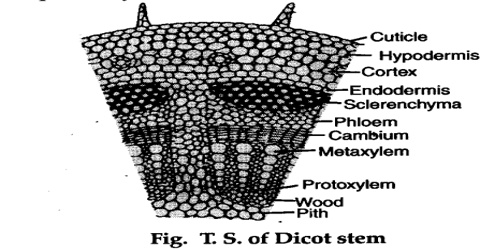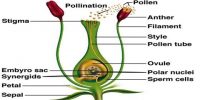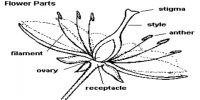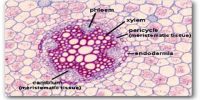The internal structure of dicot stem
A plant whose seed contains two cotyledon or embryonic leaf is known as a dicot. This article briefly focuses on the characteristics and anatomy of the dicot stem. The microscopic structure of T.S. of sunflower (Helianthus annus) stem shows the following distinct regions:
Epidermis; Cortex (hypodermis, general cortex, endodermis); Pericycle; Medullary rays; Vascular bundles and Pith.
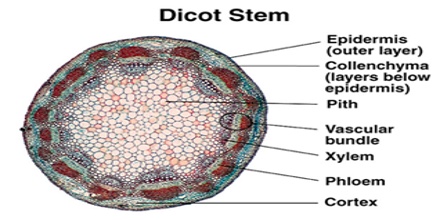
(i) Epidermis: Epidermis is the outermost single-layered covering of stem having no intercellular spaces. A thick cuticle layer is present on the outer surface of epidermis. The cells are living, barrel-shaped and compactly arranged without intercellular spaces and chloroplasts. It is covered by a cuticle to reduce transpiration. Multicellular hairs are also present. They may contain stomata for gaseous exchange. Several multicellular hairs and stomata are present in the epidermis. The epidermal multicellular stem hairs help in protection and heat loss. It is protective in function.
(ii) Cortex: Inner to the epidermis is cortex consisting of multilayered hypodermis and parenchymatous cortex to present automatic strength. Cortex is distinguished into three layers, such as- Hypodermis, general cortex, and endodermis.
- Hypodermis consists of 3-5 layers of collenchyma without spaces. Due to the occurrence of a chloroplast, it also helps in photosynthesis. It gives mechanical support.
- The general cortex encloses intercellular spaces with resin ducts, each surrounded by a layer of small thin-walled spherical or oval cells. It also helps in gaseous exchange and storage of food materials.
- The endodermis is the outermost layer of cortex having barrel-shaped parenchyma cells containing starch grains. It is the innermost layer of cortex it consists of a single layer of barrel-shaped cells. It stores starch and often called starch sheath.
(iii) Stele: The middle division of the stem inner to endodermis is known as stele. Stele includes pericycle, vascular bundles, pith (medulla) and pith rays (medullary rays). Pericycle occurs between the vascular bundle and endodermis. Pith is extensively developed and occupies the central portion of the ground tissue. It helps in the storage of food materials.
(v) Vascular bundles: Vascular bundles vary from 5-7 in numbers and are set in a ring. They are open and collateral. They are arranged in the form of a ring around the pith. Each bundle is composed of outer phloem and inner xylem on the same radius with a strip of cambium in between them. They are conjoint, collateral, endarch and open.
- Conjoint collateral or by-collateral and open
- They are arranged in a ring
- Meta-xylem lies towards the periphery while proto-xylem lies towards the center.
(vi) Medullary rays: Medullary rays are parenchymatous, radially elongated or polygonal cells lie in between vascular bundles. It helps in the radial conduction of water and food materials. Example – Sunflower (Helianthus annus).
Cambium: Cambium is a thin strip of two or three-layered cells that are radically arranged. It lies between xylem and phloem.
